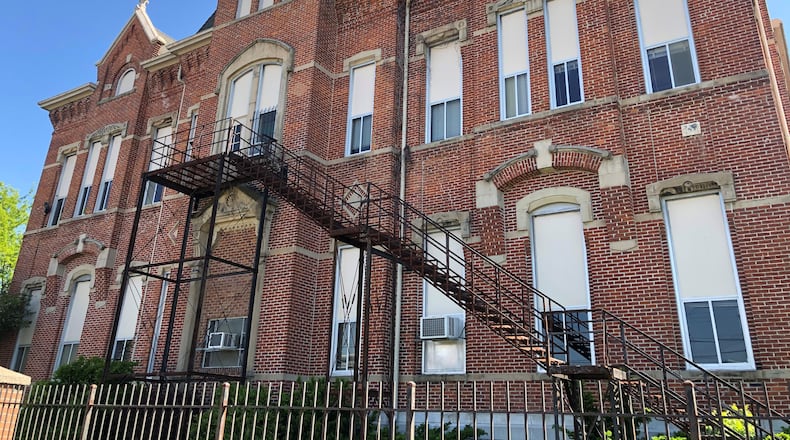Many residents who live in the area hope the opening of the market marks the dawn of a new day for the lower Salem Avenue corridor, which they say has been underserved and overlooked.
The market is a big addition and speaks to the area’s potential, said Tim Forbess, CEO of G.F. Bailey, one of the co-developers and joint partners on the project.
“What excites us about the property is the neighborhood, and more specifically the neighbors,” Forbess said. “We’ve listened to many of our neighbors and heard their deep hopes that Longfellow will be able to continue as an anchor in the neighborhood.”
But the Longfellow school project is seeking state historic tax credits and will have to compete for financing with projects across the state, including two in downtown Dayton that also propose millions of dollars in new investment.
G.F. Bailey Companies and Weyland Ventures propose repurposing a group of the Longfellow Learning Center’s interconnected buildings into housing, according to an application for state historic preservation tax credits submitted to the state.
The original school was built in 1882, but multiple additions were constructed between 1910 and 1965, creating new classrooms, an auditorium, cafeteria, library and shop space.
The group of buildings contain about 40,000 square feet of space and have been vacant since 2017, the application states.
Most of the space will be converted into about 54 apartments for residents 55 and older that will be managed and operated by United Church homes.
The development partners also want to construct a new, 70,000-square-foot building offering about 72 apartments.
The new brick-veneer building will connect to the former cafeteria and library facility, which will be turned into a community library, lounge space and dining hall for residents, the application says.
The development team also proposes renovating a historic auditorium and gymnasium.
Dare 2 Defy, a theater company, has signed a letter of intent to lease the space for performances and practices, the application states.
Weyland Ventures is a Kentucky-based developer that has used state historic tax credits to rehab commercial buildings near the Oregon District into the Wheelhouse and the Motor Car office building.
United Church Homes owns and manages senior living and affordable housing developments in a variety of states.
The partners are seeking about $3.7 million in state historic preservation tax credits.
“The Salem Avenue corridor and historic Grafton Hill neighborhood have some wonderful existing infrastructure and directly connect to downtown Dayton,” MK Lindsey, project manager for developer Weyland Ventures, told this newspaper earlier this year. “The opportunity to build on this existing neighborhood fabric fits perfectly with our mission to create thriving urban neighborhoods in great cities like Dayton.”
Residents who live along Lower Salem Avenue say they believe better days lie ahead for the corridor.
The Gem City Market opened last week to large and enthusiastic crowds, and supporters say the $7 million investment hopefully will help revive the area and will be followed by a wave of new investment.
The city of Dayton is reconstructing Salem Avenue to shrink sections of the roadway and add new pedestrian elements and new sidewalks, curbs and decorative lighting.
Local residents hope to attract new investment to the Colonel White school property on Niagara Avenue, just a couple blocks off Salem Avenue. New gateway features were added late last year at Salem and Riverview avenues.
Credit: Jim Noelker
Credit: Jim Noelker
No guarantees
But the Longfellow project is seeking highly competitive tax credits that other adaptive-reuse projects crave.
Columbus-based Windsor Companies has requested nearly $1.2 million in credits for a proposed $11.9 million rehab of the Price Stores and the adjacent Journal Herald buildings, near the corner of South Jefferson and East Fourth streets.
Windsor proposes turning the four upper floors of the Price Stores building (also known as the Home Telephone Co. building) into 20 residential units, according to its state historic tax credit application.
Credit: Tom Gilliam
Credit: Tom Gilliam
The upper floors of the four-story Journal Herald building will house 15 new housing units. The first-floor space in both buildings will be used by commercial tenants, the developers said.
The project will improve more than 60,115 square feet of space.
Windsor Companies has a strong track record of winning tax credits and putting them to good use in Dayton.
The firm has transformed the Fire Blocks District with the help of tax incentives to rehab the Elks, Huffman Block and Dayton Power & Light buildings into a mix of uses.
Windsor is finishing work on the Graphic Arts loft apartments on South Ludlow Street, which also received historic tax credit funding support.
Lasst year, the company received a historic tax credit award worth more than $3.7 million to help renovate the Grant Deneau Tower, Dayton’s first modern skyscraper.
Another Dayton project seeking funding is the Reed-Steffan building at 16-18 W. Fifth St.
The owner, Triad Architects, proposes spending $5.1 million to create lower-level restaurant and entertainment space and new offices and apartments above.
The property most recently was used by a local chess club and a college bookstore.
The company says it has a letter of intent from an anchor tenant that would lease nearly two-thirds of the first floor.
About the Author







